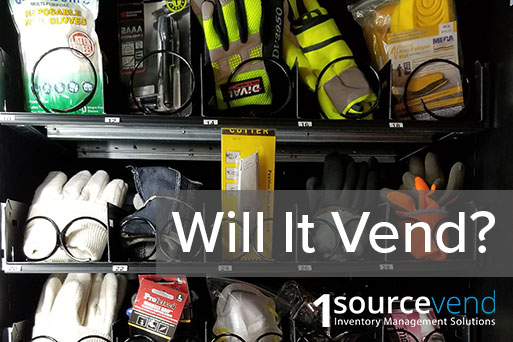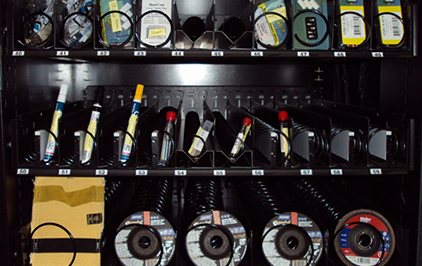
The 1sourcevend team has received a lot of questions lately about vending machine configuration and what sorts of products you can put into a vending machine. We sat down with Sales and Marketing Manager Brett Canale, who works with our customers to set up 1sourcevend vending machines, to find the answers.
What kinds of products can go into a vending machine?
It’s pretty obvious what can go into a locker machine: anything that fits into that square hole. Most of the questions I get are about coil machines. Of the thousands of coil machines that most people walk by in their lives, 97% of them are vending out chips, cookies, candy bar, peanuts or gum. So you start thinking that’s all they can vend.
People ask what kinds of products can be vended, but the better question is what can’t be vended? Coil machines are amazingly flexible, so I’ve seen all kinds of products – from customers in a huge variety of industries – go through these machines.
What are some of the tools you use to get items to vend properly?
We can place the coils as close together or as far apart as we want, and the coils themselves come in different sizes. We have three different diameters of coils and then for each of those, about 15 different options for slot sizes (the space between each coil where the product sits).
To hold the handle up on things like paints rollers or mallets or similar items, we can also put in something we call a rail kit, which is just a white bar that runs through the middle of the coil. We also use something called a splitter to stand up tall items like pens, box blades, X-Acto knives, drill bits, things like that. And to vend the really small items, like batteries and carbide drill tips, we use a little V-shaped piece we call a mini dispenser to keep things from falling before they’re vended.
Sounds like you can vend just about anything. Any caveats?
 I can rig coils to vend things you wouldn’t even imagine. We serve many industries and are adding new ones all the time. We don’t care what it is the customer wants to vend – that’s why we always just tell customers that we vend widgets. We’re agnostic as to what it is.
I can rig coils to vend things you wouldn’t even imagine. We serve many industries and are adding new ones all the time. We don’t care what it is the customer wants to vend – that’s why we always just tell customers that we vend widgets. We’re agnostic as to what it is.
That said, naturally there are some limits. For a coil machine, the item does have to be small enough to come out of the bin door, which for 1sourcevend is about 6″ x 14″. The bin itself is about 20″ deep, so you can dispense some pretty large items through there.
If the item is especially large or heavy, it does need to go into a locker, since the machine motors do have their limits. One thing that I’ve tried to vend in a coil machine and couldn’t was one of those Tingley canvas rain suits. We tried to fold up a 2X rain suit into a square that’s about 24″ by 18″ by 2″ thick, and it was just too big for a coil.
We have managed to vend some pretty large items through our coil machines. Recently we set up a machine to vend a 7″-diameter grinding disk, for example. And for a painting contractor we’re vending the Kevlar suits and respirators and paint roller handles – everything they need – with coils.
Are there any products that it wouldn’t make sense to vend from a cost or profit perspective?
In general, machines are a lot more affordable than they used to be. And 1sourcevend’s machines in particular make that initial investment cost less of a concern, even for smaller facilities. Vending machines greatly reduce inventory costs, so it’s less a question of what items make financial sense to vend and more a question of “what items would I like to have better control over and store more securely?” If the item is important enough to track in the first place, it makes sense to vend it.
We’ve seen some pretty cheap products go into machines, and some pretty expensive products go in. If the traditional vending guy has found a way to make money vending packs of gum and Snickers bars, then it opens up a whole world of opportunities for things that are more expensive.
Do you ever have to repackage things to get them to vend?
That’s very rare, but it does happen on occasion. Here’s an example: We were setting up about a 5″-diameter roll of brown box tape we wanted to vend by leaning it between two coils set up to spin at the same time. But what was happening is the adhesive on the edges of the tape was grabbing the coils, and it would stick and bind up. So they had to put each roll in a plastic bag – pretty easy to do.
Who sets up the machine – 1sourcevend or the customer?
For new customers, 1sourcevend is very involved in the configuration process. We start with a list of items the customer wants to vend, and for most of them I already know the best way to vend them.
If there are items I’m not as familiar with, I’ll ask for packaging dimensions, a picture or even have them send me a sample so I can test it on one of our demo machines. I would rather spend a little bit of time on the front end getting it right, because it’s going to make it easier on the person stocking the machine, saving them time and effort on the back end.
A lot of our existing customers have done enough of these with us in the past and they’ll just call me and say, “Here’s what I want the machine to look like. Send me three.”
When a customer receives a machine, the coils and everything are already set up in the right places. All they have to do is stock the products into the right rows using the map we’ve provided, confirm the planogram setup in the software, and they’re ready to go. In fact, because our software is cloud-based, they can do the software side of things in advance while they’re waiting for the machine to arrive. Then when they plug in and connect to a network, it pulls all that information over. If they’ve done the work on the front end, then their machine setup time will be very, very minimal.
Can customers change machine configuration after the fact, to vend different products?
Yes, no problem. The machine is modular, so they can make changes. We have a collection of videos on our YouTube channel that shows people how to reconfigure the machines. If we get a question that isn’t covered in a video yet, we just walk over to our demo machine, make the video and get it posted so they can see what they need to do.
